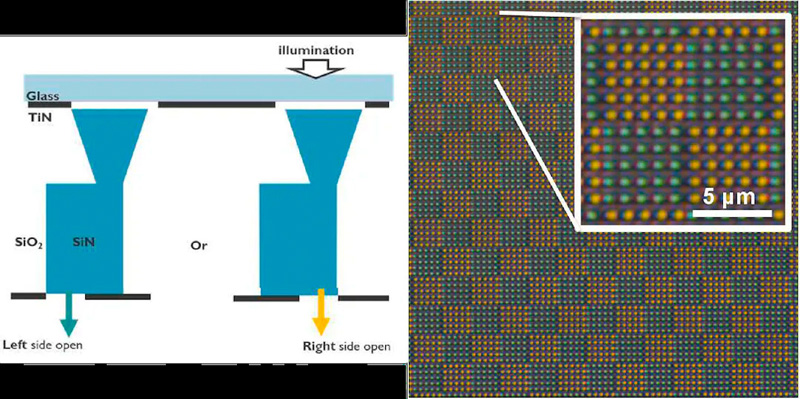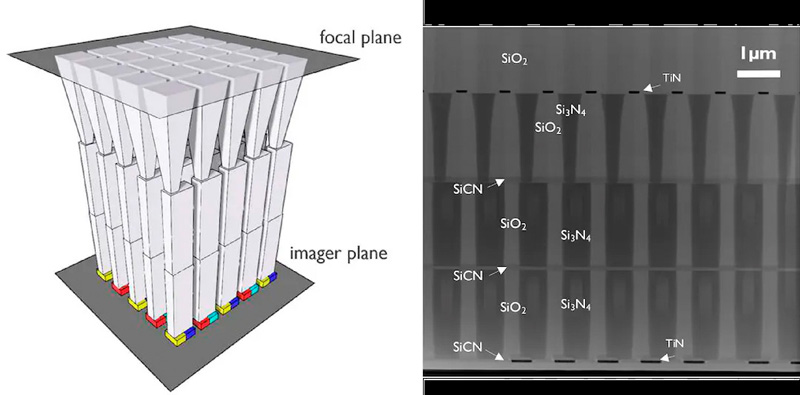News article: https://optics.org/news/14/12/11
imec presents new way to render colors with sub-micron pixel sizes
This week at the International Electron Devices Meeting, in San Francisco, CA, (IEEE IEDM 2023), imec, a Belgium-based research and innovation hub in nanoelectronics and digital technologies, has demonstrated a new method for “faithfully splitting colors with sub-micron resolution using standard back-end-of-line processing on 300mm wafers”.
imec says that the technology is poised to elevate high-end camera performance, delivering higher signal-to-noise ratio, enhanced color quality with unprecedented spatial resolution.
Designing next-generation CMOS imagers requires striking a balance between collecting all incoming photons, achieving a resolution down to photon size or diffraction limit, and accurately recording the light color.
Traditional image sensors with color filters on the pixels are still limited in combining all three requirements. While higher pixel densities would increase the overall image resolution, smaller pixels capture even less light and are prone to artifacts that result from interpolating color values from neighboring pixels.
Even though diffraction-based color splitters represent a leap forward in increasing color sensitivity and capturing light, they are still unable to improve image resolution.
'Fundamentally new' approach
imec is now proposing a fundamentally new way for splitting colors at sub-micron pixel sizes (i.e., beyond the fundamental Abbe diffraction limit) using standard back-end processing. The approach is said to “tick all the boxes” for next-generation imagers by collecting nearly all photons, increasing resolution by utilizing very small pixels, and rendering colors faithfully.
To achieve this, imec researchers built an array of vertical Si3N4 multimode waveguides in an SiO2 matrix. The waveguides have a tapered, diffraction-limited sized input (e.g., 800 x 800 nm2) to collect all the incident light.
“In each waveguide, incident photons are exciting both symmetric and asymmetric modes, which propagate through the waveguide differently, leading to a unique “beating” pattern between the two modes for a given frequency. This beating pattern enables a spatial separation at the end of the waveguides corresponding to a specific color,” said Prof. Jan Genoe, scientific director at imec.
Cost-efficient structures
The total output light from each waveguide is estimated to reach over 90% within the range of human color perception (wavelength range 400-700nm), making it superior to color filters, says imec.
Robert Gehlhaar, principal member of technical staff at imec, said, “Because this technique is compatible with standard 300-mm processing, the splitters can be produced cost-efficiently. This enables further scaling of high-resolution imagers, with the ultimate goal to detect every incident photon and its properties.
“Our ambition is to become the future standard for color imaging with diffraction-limited resolution. We are welcoming industry partners to join us on this path towards full camera demonstration.”
RGB camera measurement (100x magnification) of an array of waveguides with alternating 5 left-side-open-aperture and 5 right-side-open-aperture (the others being occluded by TiN) waveguides at a 1-micron pitch. Yellow light exits at the right part of the waveguide, whereas the blue exits at the left. The wafer is illuminated using plane wave white light. Credit: imec.
3D visualization (left) and TEM cross-section (right) of the vertical waveguide array for color splitting in BY-CR imaging. Credit: imec.


Appears to be a vertical multi-mode interference (MMI) filter.
ReplyDeleteSee this paper for the more common planar implementation of such a device: https://doi.org/10.1364/OE.433260
Would be interesting to see their passbands/cutoffs.
Looks really cool. How does it handle off-axis light like is so common with wide angle optics? I recall when the CIS makers had to offset the ULS to deal with this for periphery of sensors.
ReplyDeleteMaybe like the Matalens and color routing
Delete